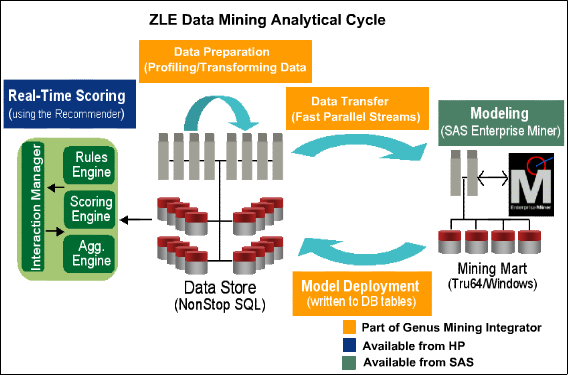| Genus Mining Integrator for NonStop™ SQL |
| Overview |
| The process of data mining |
| The ZLE data store |
| Data Preparation Tool |
| Data Transfer Tool |
| Model Deployment Tool |
| Ordering Information |
| Resource Center |
Data mining is the process of analyzing large data sets to find useful, previously undiscovered patterns. For example, data mining may be used to analyze marketing campaign results and related data to find the patterns, or factors, that differentiate people who responded favorably to the campaign from those that did not. The differentiating factors in this example may be a combination of things like marital status, disposable income, hobbies and recent product purchases. After these factors are identified, they can be used to optimize future campaigns by sending marketing materials to only those customers that are likely to respond favorably. HP Zero Latency Enterprise (ZLE) solutions provide an ideal environment in which to do data mining. A key factor in achieving good data mining results is the availability of quality data---that is, data that is integrated, current and comprehensive, which is exactly the kind of data that is contained in a ZLE Data Store. Another key factor in the success of a data mining effort is the ability to effectively utilize the knowledge discovered via mining. A ZLE system facilitates the effective deployment of knowledge by integrating operational systems and business processes within an organization, which are typically required to realize the full business value of data mining. For these reasons, ZLE solutions greatly facilitate data mining. Data mining, in turn, plays a central role in ZLE, providing powerful techniques for identifying the most effective ways to respond to business events. In a retail application, for example, data mining can be used to generate rules that identify credit card purchases that are likely to be fraudulent, and then the rules can be executed in real-time in a business rules engine to authorize purchases. Through this and other similar applications, data mining helps to realize the full business value inherent in the data and application integration provided by ZLE solutions. Contrary to some of the overblown claims in the popular press, the successful application of data mining requires much more than simply buying a tool and connecting it to a large database. In HP ZLE solutions, data mining is performed via a four-step process: Problem Specification: The first step in developing a data mining application is to precisely define the problem to be solved. Data Preparation: After a data-mining problem is defined, relevant source data must be identified and its suitability for solving the specified problem assessed. After suitable source data is identified, it must be transformed to the specific form required by mining tools such as Enterprise Miner from SAS. Model Building: In this part of the process, prepared data sets are analyzed via Enterprise Miner, and so-called predictive models are built. These models represent, or encapsulate, the patterns that are discovered via data mining. A variety of models may be built in Enterprise Miner, e.g., rule-based models, neural networks and decision trees. Model Deployment: The final process stage involves using the models built in Enterprise Miner in ZLE applications to respond more effectively to business events. At the heart of an HP ZLE solution is a ZLE Data Store that contains integrated and current data from across an enterprise. This data store, which resides in a NonStop™ SQL database on an HP NonStop™ Server platform, is the source data that is prepared for modeling. After a data set has been prepared, it is transferred out of the ZLE Data Store to an HP Tru64 Alpha, HP UX, or Windows ProLiant server for model building in Enterprise Miner. The models built in Enterprise Miner are then deployed back into a ZLE Data Store for use by ZLE applications and operational systems.
The ZLE data mining process is lengthy and iterative, involving the specification and execution of complex SQL statements for data preparation, and the transfer of data across platforms and systems. To mitigate the complexity inherent in the process, and to reduce the end-to-end cycle times, HP and Genus Software have assembled a toolset called the NonStop™ Mining Integrator, which leverages other partner products from SAS and MicroStrategy. Following are four tools in this set: This tool supports the exploration and transformation of data, providing an easy-to-use GUI, a high-level logical data model for representing and manipulating data, and automatic SQL generation. The tool is a Genus Software product that works in conjunction with the MicroStrategy Business Intelligence Toolset. Click here for Detail >> This tool supports the efficient and parallel transfer of large data sets from a ZLE Data Store to an analytical server for analysis in SAS Enterprise Miner. The tool, which is a Genus Software product, provides an intuitive and convenient web browser interface for transferring a table from a ZLE Data Store directly into a SAS data set on an analytical server. Click here for Detail >> This tool supports the transfer of model information from a SAS repository to a ZLE Data Store. The available models in a SAS repository may be viewed through a web browser interface, then selected models deployed into a ZLE Data Store through the same interface. This tool is also a product of Genus Software. Click here for Detail >> Recommender and Scoring Engine Executes SAS models deployed into a ZLE Data Store. The tool is available from HP as part of the ZLE Developer’s Kit (ZDK). Ordering Information (Can be ordered from HP or Genus)
|
|||
© 1996-2004, Genus Software, Inc., All rights reserved.
